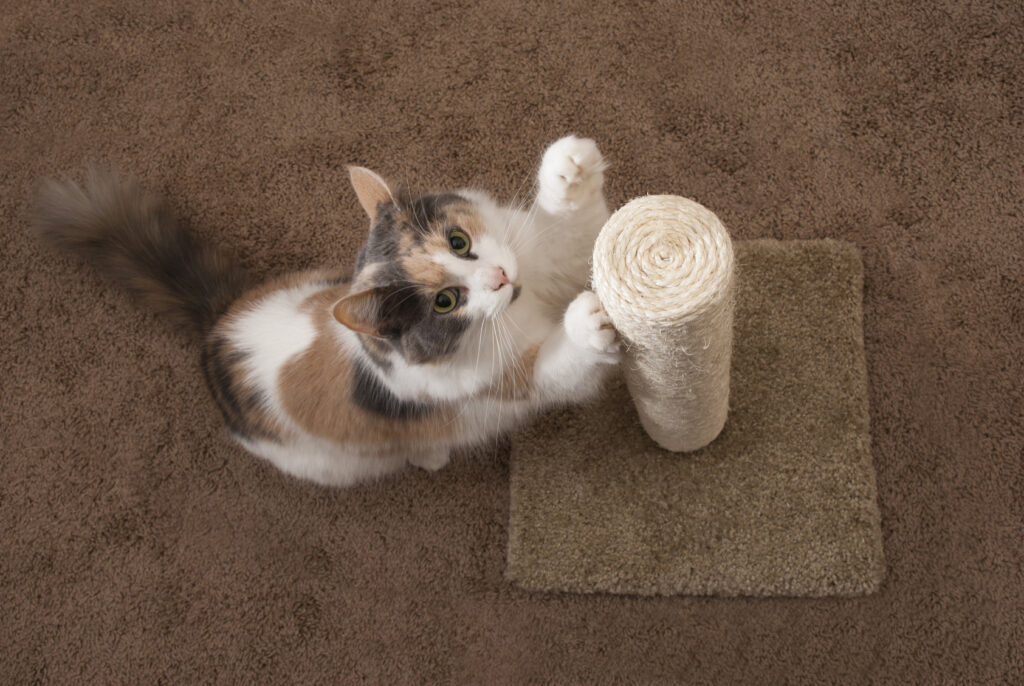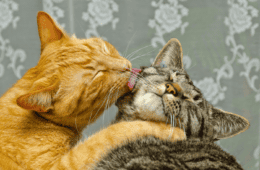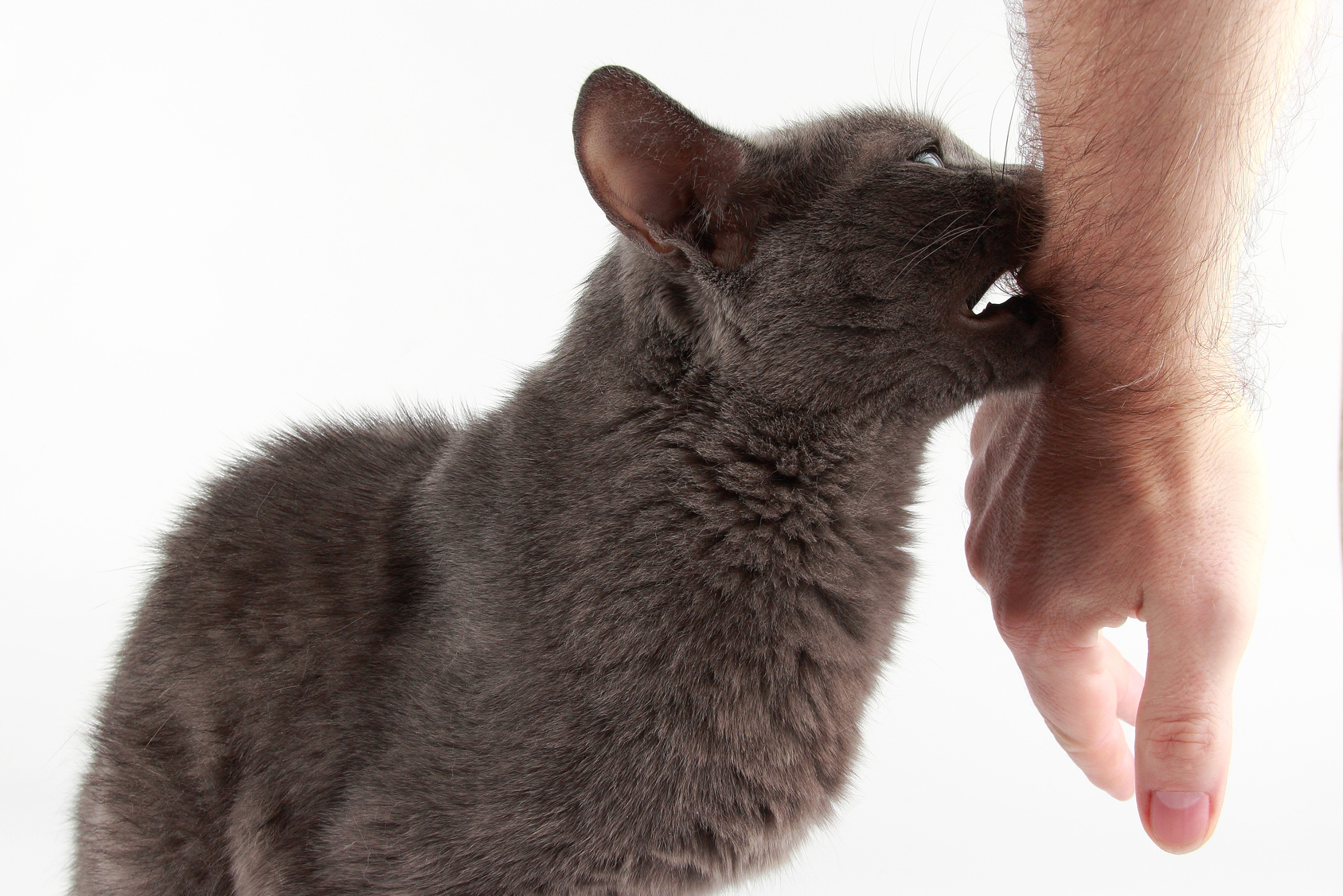Ever wondered if it's possible to coexist with a cat while maintaining pristine furniture? Frustrated owners often resort to drastic measures like declawing or even parting ways with their beloved cat companions.
But fear not! There are alternatives to these extreme solutions. By understanding your cat's needs and providing suitable scratching alternatives, you can avoid furniture damage.
And if all else fails, numerous products exist to deter damage without harming your cat. Let's explore the secrets to harmonious living with your feline friend.
Why Do Cats Scratch?
Scratching objects is natural for all cats and has several reasons. First, by scratching a rough surface, your cat loses the outer sheath of the nail, which is necessary for keeping the claws sharp and healthy. Scratching also serves as a means to mark territory. Cats have special glands on their paws that secret individual scent marks. We cannot smell those, but for other cats, they serve as a clear signpost. Scent marks are accentuated by the visual scratch marks, making a scratching post the feline equivalent of a personal signature.
Another important function that scratching serves is to let the cat release pent-up energy or emotional stress. Many cats will scratch when they are excited, either by their owner's arrival or by another cat's comings and goings.
Last, but not least, cats simply enjoy a good stretch when they scratch a surface. That is why many cats like to have a good scratch as part of their wake-up stretching routine.
Problem Scratching And How To Stop It
Although scratching behavior is natural and healthy for all cats, it can have a devastating effect on the object used as a scratching post. Over time, daily contact with the sharp claws causes significant damage to wood or fabric. If Kitty has chosen a piece of furniture or the living room carpet as her scratching post, it can be a serious problem. The first step to solving the problem is realizing that the cat is just practicing normal feline behavior. She is not being bad or trying to cause damage - she simply uses the best scratching post she can find.
What we need to do is not prevent her from using her claws altogether, but rather redirect that behavior to an object that will serve as a proper scratching post. Only after we provide Kitty with an acceptable scratching post can we begin to teach her that the furniture is out of bounds.
Selecting The Perfect Scratching Post
Many owners go out to get Kitty a designated cat scratching post. They invest a lot of money in an expensive post only to find out that their cat still prefers the sofa. The problem is that cats are individuals and different cats prefer different kinds of scratching posts. You may need to experiment with several types of scratching posts until you find the one that your cat likes best. The post's location is also significant - the right post in the wrong place may not be attractive enough. Here are some things to consider when setting a scratching post for your cat:
Vertical Or Horizontal Preference, Stability, And Size, Texture Matters
Stability - Scratching puts a lot of pressure on the scratched object and if it's not sturdy enough it will probably wobble or even topple over. The rule here is to find a scratching post that is as stable as any heavy furniture and as unmovable as a wall-to-wall carpet.
Size - When your cat scratches the post, she is also performing a full-body stretch. To do that, most cats need a scratching surface that is at least 28-30 inches long. Very small cats may do with surfaces that are smaller, but the rule is the longer, the better.
Vertical or Horizontal - This really a matter of the cat's personal taste. Some cats prefer vertical scratching posts while others go for horizontal ones. You may have to experiment with both kinds until you find out what your cat likes best.
Texture - The scratching post should be covered with some rough material that your cat can use as a good nail file. Cats also take a visual cue from a surface and if it looked a bit scratched it may be more attractive.
Here too, different cats have different preferences. Sisal, rope, and carpets are usually welcome. Some cats prefer cardboard or rough fabrics. Again, you may need to experiment to discover your cat's particular taste.
Read more here: Cat Furniture: A Comprehensive Guide to a Happy Home for Cats
SIGN UP FOR THECATSITE'S EMAIL UPDATES >
Location Is Key
Even if you find the ideal scratching post for your cat, she may choose not to use it if it's not located in the right place. Consider the situations when your cat scratches. It's usually when she gets up from a nice nap, to have a good stretch, or when she greets you as you get into the house, as a way to release pent-up excitement.
If she can't find a suitable scratching post nearby, chances are she'll go for the furniture or carpet. So, don't hide the post in the basement - place it in a prominent area of your house, clearly visible to your cat. If you live in a large house, your cat may require more than one scratching post.
Training Your Cat To Use The Scratching Post
Once you provide your cat with the right post for her, you need to make sure that she uses the post and avoids your furniture. Kittens learn scratching behavior when they are several months old, so don't be surprised if your ten-week-old kitten still doesn't use the post.
With time, Kitty will discover the joys of clawing and you need to make sure that she knows where is the best place for it. Whether training a kitten or an adult cat, don't make the common mistake of trying to put the cat's paws on the scratching post for her. Cats don't like to be handled this way and you risk creating a negative association with the post.
Instead, get the cat interested in the post by playing interactive games around it. Make the cat chase a toy around and on the post. During the chase, the cat will probably try to claw at the toy and will probably discover the pleasant surface.
When she does she may actually begin to scratch the post as a way to relieve the pent-up excitement caused by the game. When this happens, give plenty of praise in a pleasant quiet tone. Be patient - this may take a few sessions and you want your cat to be relaxed and playful.
Read more here: 8 Superb Automated Cat Toys That You’re Going To Love!
Preventing Furniture Damage
If your cat has already discovered the charms of your furniture, you need to make them less appealing; at least until you're sure that the cat is using only the scratching post. You can cover the furniture with aluminum foil or better still with Cat Training Tape - a special transparent product that prevents the cat from scratching the covered surface.
Click Here To See Cat Training Tape On Amazon.
You can also try using a special repellant spray on your furniture for the same purpose, but bear in mind that some cats are not affected by the spray.
Click Here To See This Deterrent Spray On Amazon.
Remember you can only use these preventive measures after you have provided your cat with an appropriate scratching post and made sure that she knows where it is and how to use it.
When Behavior Modification Falls Short
In the long run, it is better to take the time and follow the training program detailed above. If for some reason you cannot do this or you want a faster solution, consider using special plastic caps for your cat's claws, known as Soft Paws or Soft Claws.
Click Here To See Soft Claws On Amazon.
These colorful plastic caps are glued on the cat's trimmed claws and take away their destructive edge. Your cat will still be able to retract the claws and use them as usual. She will go through the motions of scratching and enjoy the benefits of this behavior, but no damage will be caused to your furniture.
The caps need to be replaced every three months and the cat's claws need to be trimmed before application. Members of TheCatSite.com's forums who have used this product reported excellent results and ease of use.
Why You Should Never Declaw
Feline onychectomy or Declawing is a radical procedure that involves amputating the cat's toes at the first knuckle. This is an extremely painful procedure that is nothing short of mutilating the cat.
Many cat experts agree that robbing the cat of one of the most natural feline behaviors can lead to serious behavior problems later on. Declawed cats are probably more prone to become biters and some of them may develop litter box problems as well. Unfortunately, there are still many vets in the United States that offer declawing as a routine procedure, along with spaying or neutering. Declawing may be routine for the vet (and quite profitable as well), but it is unnecessary and extremely painful, and traumatic for your cat.
In most Western countries this procedure is actually illegal.
As caring cat owners, we have the responsibility to stay educated and protect our cats from being declawed until the law changes in the US.
Training your cat to use a scratching post may take a little bit of time and effort, but with so many products available to help you, there is really no need to resort to declawing.
Achieving Harmony: A Guide To Preventing Furniture Scratching By Cats
In summary, living harmoniously with your feline friend and maintaining beautiful furniture is possible. By understanding the reasons behind scratching and providing suitable alternatives, you can redirect your cat's behavior and protect your belongings.
Remember to select the right scratching post, engage in positive training techniques, and utilize preventive measures when needed. Let's prioritize our cats' well-being and preserve the beauty of our homes, ensuring a happy coexistence.
Comments? Leave them using the form below. Questions? Please use the cat forums for those!
You might also like:
Should You Trim Your Cat’s Back Claws?
How To Best Take Care Of Cat Claws
SIGN UP FOR THECATSITE'S EMAIL UPDATES >
Note: We may get commissions for purchases made through links on this page.








3 comments on “How To Stop Your Cat From Scratching The Furniture”